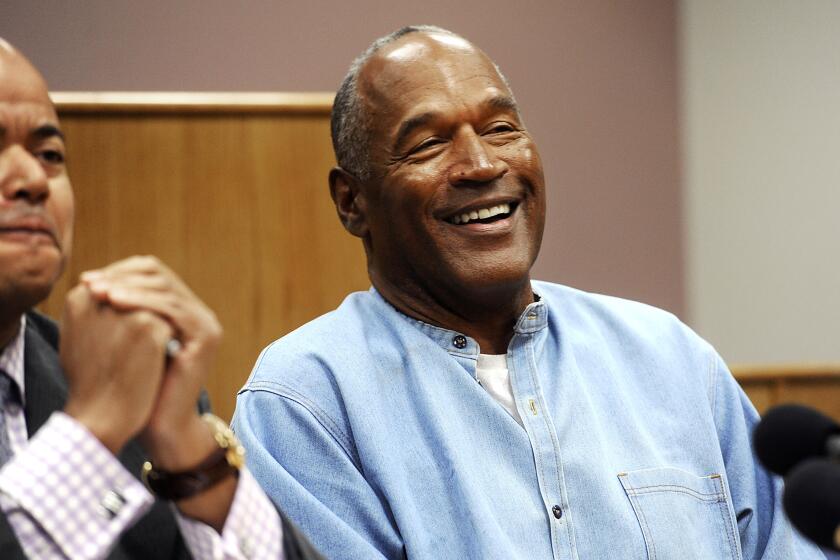A city is born, maybe
LET’S CLEAR UP the geographical quirks first.
There is the east side of Los Angeles, which is the part of the city of Los Angeles that lies east of the L.A. River. It is home to neighborhoods like Highland Park and Lincoln Heights, and it is sometimes collectively called “the Eastside” -- one word. (The same holds for “the Westside,” the part of the city that lies west of whatever money meridian celebutantes refuse to cross.)
And then there is East Los Angeles.
It is not the Eastside, nor is it part of the city of Los Angeles. It is east of Los Angeles, in L.A. County, an “unincorporated area” hunkered between Boyle Heights and Monterey Park, Commerce and Montebello. Its seven-ish square miles are bounded by more freeways than Beverly Hills and Brentwood and Bel-Air have put together.
East Los Angeles is the foundry of many things Mexican American: zoot suiters, dazzling murals, cherry low-riders, Los Lobos music, Chicano protests and Garfield High, where Bolivian-born Jaime Escalante taught his students college-level calculus. And here in “East Los” 20 years ago, Richard Anthony Marin -- Cheech, short for “Chicharron,” Marin -- starred in the comedy “Born in East L.A.,” about a Mexican American mistakenly deported to Mexico; some things, as recent headlines prove, do not change. (Marin, who lives in Malibu, the 88th incorporated city in Los Angeles County, unfortunately wouldn’t say anything about the prospect of East L.A. becoming the 90th city in Los Angeles County. Too bad; he’d have a great shot at becoming mayor.)
East Los has been trying to become its own city since Cheech Marin was a teenager.
The first time, about a week after the Bay of Pigs disaster in 1961, the bid lost by 340 votes. The second time, in 1964, cityhood supporters couldn’t get enough signatures on the petitions. The third time, in 1974, the idea got clobbered by East L.A. voters and buried so deep that it hadn’t been undertaken again in more than 30 years.
Poor East Los.
Always the dama at someone else’s quinceanera. It’s had to watch as Hidden Hills and Palmdale and Carson and Diamond Bar and Westlake Village all grew up and became cities. Vernon -- population under 100, which doesn’t count the doomed critters about to be turned into Dodger Dogs -- has been a city for more than 100 years. Even Hawaiian Gardens -- a midget of a town named after a bootlegger’s punch stand -- became a real burg.
Now East L.A. wants to try again, on the November 2008 ballot. Some of the residents are frustrated at having only one local political voice -- Gloria Molina’s. She represents its population of 143,000 on the county Board of Supervisors, but she represents another 1,857,000 people too.
Those early cityhood elections were about pride, about waving the flag of a Latino city -- a tortilla island in the Wonder Bread ocean that was L.A. back when its Nebraska-born mayor pronounced the city’s name Loss Ang Hell Iss. Now there are Latino cities and Latino politicians all over the county, starting with a certain Antonio Villaraigosa.
You can’t eat pride, and you can’t spend it. In the 1970s, some Mexican Americans didn’t want any part of any tight little Chicano municipal club. Their biggest concern was money. How could a city of East Los Angeles support itself? Even Hawaiian Gardens has a casino.
THE BAR FOR cityhood is a very high jump. To get cityhood on a ballot, East L.A. has to qualify in the civic Olympics, as judged by a county commission. Cityhood supporters pay for a financial feasibility study. Can East Los pay its own way? How much will it cost for the sheriff’s protection that the county now writes a check for? What’s the tax base?
Can a place where one in four residents earn less than the poverty-level pay for a mayor, a city council and all the rest of the services and bureaucracy required to exchange county rule for self-rule? Only after the commission gives its approval can organizers start collecting signatures to put the question on the ballot.
Read the blogs and you’ll see that the financials aren’t being judged only by the commission. Here’s a bit from an exchange between “Laura” and “Si Mon.”
Laura: “This cannot just be about pride in a community.... It has to be about the very real financial burden that will affect every citizen.... “
Si Mon: “Yes to cityhood! Perhaps we could ... rid the area of unsightly commercial trucks, illegal home-based businesses. Most of all we get rid of the tired county supervisors.... It’s a godsend to think that my tax dollars will actually help other permanent residents.... “
Ordinarily I’d be inclined to regard the quest for cityhood as politicians hustling to create new government berths after term limits booted them out of Sacramento. Not this time -- if only because running East Los would be a tough slog. And a new city of East Los Angeles would have more claim to a civic identity and a more singular character than some other Southern California neighborhoods that were merely rich enough to cut their county moorings and make themselves into municipalities.
Make no mistake: I don’t want to open the floodgates to willy-nilly cityhood. I’d drop the hammer on any temptation for every few square miles of L.A. to declare itself a theme neighborhood and declare cityhood, cutting itself out of the larger fabric.
Start down that road and someone soon will be voting on whether to incorporate the San Fernando Valley town of Pornopolis.
More to Read
Start your day right
Sign up for Essential California for news, features and recommendations from the L.A. Times and beyond in your inbox six days a week.
You may occasionally receive promotional content from the Los Angeles Times.







